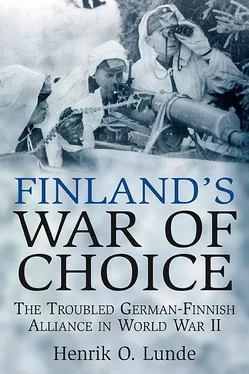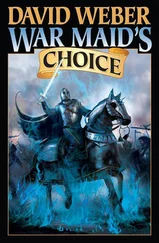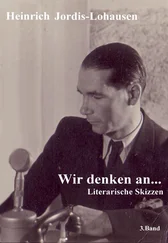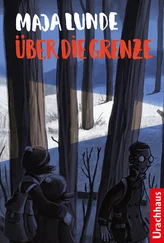29. Translation of quote in Westerlund, op. cit., p.172.
30. The Panzerfaust was a small, disposable pre-loaded tube firing a 6.4lb high-explosive warhead capable of penetrating 7.9 inches of armor. It served as a model for the Soviet RPG-2 and the later RPG-7.
31. The Panzarschreck was an 88mm reusable antitank rocket launcher similar to the US 2.36-inch rocket launcher (bazooka).
32. The 303rd Assault Gun Brigade was actually a battalion-size unit commanded by Captain Hans-Wilhelm Cardeneo. It was equipped with 22 StuG III Ausf. G., each with a 75mm high velocity assault gun as main armament. The brigade was also equipped with nine StuH 42 assault howitzers.
33. Fighter Detachment (Gefechtsverband) Kuhlmey was an ad hoc unit commanded by Lieutenant Colonel Kurt Kuhlmey. It arrived at Immola Airfield in Finland on June 17, 1944. Kurt Kuhlmey was a famous Luftwaffe pilot who was awarded the Knight’s Cross of the Iron Cross. After WWII he entered the West German Air Force and retired as a major general. He died in 1993. Detachment Kuhlmey flew over 2,700 missions in Finland and is credited with shooting down 150 Soviet aircraft and destroying 200 tanks. It lost 41 aircraft. See Christer Bergström, Bagration to Berlin: The Final Air Battles in the East 1944–1945 (Buress Hill: Classic Publications, 2008).
34. Vehviläinen, op. cit., p.139.
35. Notes by Tanner, June 19 and 20, 1944 as cited by Vehviläinen, op. cit., p.139.
1. OKW War Diary (Kriegstagesbuch), Report, The Northern Theater of War, January 4–December 31, 1944, pp.29–30 as cited in Ziemke, The German Northern Theater of War, pp.284–285.
2. Ibid, p.285.
3. Vehviläinen, op. cit., p.138 and Shtemenko, op. cit., pp.360–361.
4. Erfurth, The Last Finnish War, p.194.
5. Westerlund, op. cit., p.203.
6. Matti Koskimaa, Veitsen terällä: vetäytyminen Länsi-Kannakselta ja Talin-Ihantalan suurtaistelu kesällä 1944 (Porvoo: W. Sönderström, 1993), p.70 as cited in Westerlund, op. cit., p.181.
7. Westerlund, op. cit., pp.182–184.
8. Ibid, p.184.
9. Vehviläinen, op. cit., p.139.
10. Earl F. Ziemke. Stalingrad to Berlin: The German Defeat in the East (Army Historical Series. Original publication date 1968. New York: Barnes & Nobles, 1996), p.300.
11. Waldemar Erfurth writes that he had “some evidence of a possible Finnish decision to bind themselves closer to the Reich.” Erfurth, The Last Finnish War, p.186.
12. Blücher, op. cit., p.371.
13. Mannerheim, Memoirs, p.482.
14. Loc. cit.
15. Loc. cit.
16. Erfurth, The Last Finnish War, pp.186–187 and Vehviläinen, op. cit., p.142.
17. Ziemke, op. cit., p.283.
18. Vehviläinen, op. cit., pp.142–143.
19. Raunio, op. cit., pp.252–253. The discrepancy in the numbers given by Vehviläinen and those units listed by Raunio is probably due to the former counting the 122nd German Infantry Division and not counting the 3rd Coastal Regiment along the shore of Lake Ladoga.
20. Westerlund, op. cit., p.194.
21. Erfurth, The Last Finnish War, p.190.
22. Clausewitz, On War, VIII: 6, p.603.
23. Ziemke, Stalingrad to Berlin, pp.300–301.
24. Erfurth, The Last Finnish War, p.189.
25. Ziemke, The German Northern Theater of Operations, p.284.
26. General Rendulic was one of several officers who rose to high position in the German Army in the closing months of World War II. Another who also came from the Finnish theater of war was Ferdinand Schörner. They were valued by Hitler for their unquestioned loyalty and harshness bordering on brutality. In his book Stalingrad to Berlin (pp.432–433) Ziemke writes “Rendulic, in the few months left in the war, was setting out to carve for himself a niche in history next to Schörner. One characteristic remarked on by all of his former superiors had been his absolute nervelessness…. In one order he made the battalion and regimental commanders responsible for every ‘foot of ground’ voluntarily given up and appended the example of a captain he had ordered shot the day before for taking his battalion back a mile after it had been broken through. In another, he ordered ‘flying courts-martial’ created to scour the rear areas. Every soldier not wounded, picked up outside his unit area, was to be tried and shot on the spot.”
27. Ziemke, The German Northern Theater of Operations, p.286.
28. Erfurth, The Last Finnish War, pp.188, 192, 193.
29. Ibid, p.194.
30. Vehviläinen, op. cit., p.143 citing Tanner’s notes from July 22, 1944.
31. Mannerheim, Memoirs, p.492.
32. Ziemke, Stalingrad to Berlin, p.387.
33. Ibid, p.388.
34. According to General Erfurth, The Last Finnish War, p.201, the idea of the visit originated with General Rendulic, the commander in chief of the 20th Mountain Army. Rendulic had reported to Hitler that the quick turn in the political situation in Finland was caused by a message from Roosevelt to Ryti, discussions with British representatives in Lisbon, and the withdrawal of the 122nd Division. He recommended that the 122nd Division be left in Finland.
35. Mannerheim, Memoirs, pp.492–493; Blücher, op. cit., pp.395–396; Erfurth, The Last Finnish War, p.206; and Vehviläinen, op. cit., p.144.
36. Vehviläinen, op. cit., p.145.
37. Mannerheim, Memoirs, p.493.
38. Blücher, op. cit., p.369, Ziemke, The German Northern Theater of Operations, p.290.
39. Vehviläinen, op. cit., p.145.
40. Mannerheim, Memoirs, p. 493.
41. Lothar Rendulic, Gekämpft, Gesiegt, Geschlagen (Wels: Verlag Welsermühl, 1952), p.283–284, and Mannerheim, Memoirs, pp.495–496.
42. Mannerheim, Memoirs, pp.497–498.
43. Ibid, pp.494–495.
44. Ibid, pp.499–500.
1. The number of men drawing rations in the middle of August was 204,064. Erfurth, The Last Finnish War, p.221.
2. Hölter, op. cit., p.37.
3. Erfurth, The Last Finnish War, p.221.
4. Shtemenko, op. cit., p.347.
5. Ibid, pp.369–371.
6. Vehvilainen, op. cit., p.149 and Erfurth, The Last Finnish War, p.224.
7. Vehvilainen, op. cit., p.149.
8. 20th Mountain Army War Diary scattered entries September 1–December 18, 1944, as referenced in Ziemke, The German Northern Theater of Operations, p.293. See also Rendulic, op. cit., pp.286–287.
9. Ziemke, The German Northern Theater of Operations, p.292 and Erfurth, The Last Finnish War, p.224.
10. Ziemke, The German Northern Theater of Operations, p.296.
11. Mikkola, op. cit., p.30.
12. Westerlund, op. cit., p.212.
13. Erfurth, The Last Finnish War, p.226 reports that the fighting lasted two days. This is not supported by Finnish sources.
14. Raunio, op. cit., p.187. Earl F. Ziemke, Stalingrad to Berlin, p.394, writes that the Finns reported the capture of 700 prisoners based on a German Naval War Diary entry.
15. Ziemke, Stalingrad to Berlin, p.394, reports that Rendulic initially refused but that a compromise was worked out with the Finns.
16. Erfurth, The Last Finnish War, pp.225–226 and Ziemke, The German Northern Theater of Operations, p.295.
17. Hölter, op. cit., pp.38–39.
18. Ibid, p.43.
19. Mannerheim, Memoirs, p.503.
20. Vehviläinen, op. cit., p.150.
21. Ziemke, Stalingrad to Berlin, p.394.
22. Westerlund, op. cit., p.213.
23. Ziemke, Stalingrad to Berlin, pp.394–395.
24. Erfurth, The Last Finnish War, p.227.
25. Ibid, p.229.
26. Emil Schuler, Mit dem Bergschuh im Russland und Finnland, München: Eigenverlag Emil Schuler, 1959, pp.152–197 and Roland Kaltenegger, Schicksalsweg und Kampf der “Bergschuh” Division (Graz: Leopold Stocker Verlag, 1985), pp.287–331.
Читать дальше












